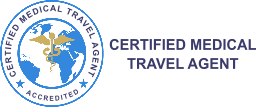Medical tourism, where individuals travel to other countries for medical treatment, has seen remarkable growth in recent years. With globalization and advancements in healthcare, more patients are seeking medical care abroad for various reasons such as lower costs, access to specialized procedures, and shorter wait times. As we move into the future, several key medical tourism trends are expected to drive the continued growth of medical tourism.
Technological Advancements Driving Medical Tourism Growth
One of the primary forces behind the growth of medical tourism is technological innovation. Emerging medical tourism trends, such as telemedicine, robotic surgery, and AI-driven diagnostics, are revolutionizing healthcare delivery, making high-quality care more accessible and efficient for international patients.
Telemedicine: Telemedicine allows patients to consult with specialists from around the world without needing to travel for initial consultations or follow-up care. This not only reduces costs but also helps to eliminate the logistical challenges of traveling for medical reasons, contributing to the overall growth of medical tourism.
Robotic Surgery and Advanced Diagnostics: Countries that invest in advanced medical technologies like robotic surgery and state-of-the-art diagnostic tools are becoming more attractive to medical tourists. These technologies offer greater precision and improved outcomes, drawing patients seeking cutting-edge treatments that might not be available in their home countries.
Blockchain for Data Security: With growing concerns over patient data privacy, blockchain technology is emerging as a key solution. It enables secure and transparent management of medical records, helping patients trust cross-border healthcare services while facilitating smoother access to their health information globally.
Evolving Patient Preferences and Their Role in Medical Tourism Growth
The preferences of patients traveling for medical care are also shifting. Today’s medical tourists are not only looking for affordable treatments but are increasingly seeking high-quality care, personalized experiences, and holistic health services.
Holistic and Wellness Treatments: Many medical tourists are combining their healthcare needs with wellness treatments. Countries like India, Thailand, and Costa Rica, known for their holistic approaches to health, are experiencing a boost in medical tourism as patients seek spa therapies, yoga retreats, and traditional medicine along with conventional medical procedures.
Personalized Medicine: With advancements in genetics and biotechnology, personalized medicine is becoming more common. Medical tourists are drawn to destinations offering tailored treatments for complex conditions like cancer and cardiovascular diseases, which are often not available in their home countries.
Ageing Population: As the global population ages, there is an increasing demand for treatments related to age-associated conditions like joint replacements, dental procedures, and cardiovascular surgeries. Countries with expertise in geriatric care and rehabilitation are expected to see continued growth in medical tourism from elderly patients seeking specialized treatments.
Regulations and Policies Shaping Medical Tourism Growth
Regulatory changes are playing an essential role in shaping the medical tourism industry. Governments and healthcare providers are adapting policies and standards to accommodate the growing demand for cross-border healthcare.
International Accreditation: Accreditation from organizations like the Joint Commission International (JCI) is becoming a key factor in attracting medical tourists. Hospitals and healthcare providers that meet stringent international standards for safety and quality are building trust and credibility among international patients, thus driving medical tourism growth.
Cross-Border Healthcare Policies: Many countries are developing policies to streamline medical tourism, such as simplifying visa processes for medical travelers and offering tax incentives to healthcare providers. These measures make it easier for patients to seek care abroad, contributing to the growth of the industry.
Insurance and Payment Models: The integration of medical tourism into health insurance plans is also expected to rise, with more insurers offering coverage for treatments abroad. Innovative payment models, such as bundled packages for medical travel, are emerging, making the process more transparent and accessible for patients.
Conclusion: The Future of Medical Tourism Growth
As we look ahead, it’s clear that the medical tourism industry is set to continue its rapid growth. Technological innovations, changing patient preferences, and regulatory developments are some of the key medical tourism trends contributing to an expanding global market. With more patients seeking affordable, high-quality healthcare abroad, medical tourism growth shows no signs of slowing down.
Reach Your Full Potential in Medical Tourism with MTB
At MTB, we are dedicated to supporting professionals and organizations in the medical tourism industry as they strive for success. We are a leading provider of certification, contracts, marketing, and support. We offer comprehensive programs, expert guidance, and valuable resources that are designed to help our members achieve their goals and reach their full potential in the global healthcare market. With a focus on excellence and innovation, we help our members stay ahead of the competition and navigate the complex and dynamic world of medical tourism.
Tel/WhatsApp: +1 (561) 909-7178








